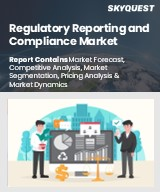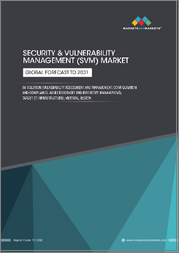
|
시장보고서
상품코드
1777289
규제 보고 및 컴플라이언스 시장 규모, 점유율, 성장 분석 : 서비스 유형별, 서비스 프로바이더 유형별, 최종사용자별, 지역별 - 산업 예측(2025-2032년)Regulatory Reporting and Compliance Market Size, Share, and Growth Analysis, By Service Type, By Service Provider Type, By End User, By Region - Industry Forecast 2025-2032 |
||||||
세계의 규제 보고와 컴플라이언스 시장 규모는 2023년에 36억 달러로 평가되며, 2024년 39억 5,000만 달러에서 2032년에는 83억 5,000만 달러로 성장하며, 예측 기간(2025-2032년)의 CAGR은 9.8%로 성장할 전망입니다.
세계 규제 보고 및 컴플라이언스 시장은 정부 규제, 기술 발전, 진화하는 컴플라이언스 프레임워크에 힘입어 크게 성장하고 있습니다. 리스크 관리 강화, 부정행위 감소, 재무 투명성 향상을 위해 자동 보고 기술 및 강력한 디지털 기반 개발에 중점을 두고 있습니다. 금융거래, 납세 기록, KYC 데이터 분석을 자동화하기 위해 블록체인과 인공지능을 활용한 실시간 규제 모니터링 시스템 등의 혁신이 도입되고 있습니다. 또한 AI와 머신러닝을 컴플라이언스 프로세스에 통합하여 실시간 모니터링, 위험 평가 자동화, 이상 징후를 쉽게 감지할 수 있으며, 수작업 개입과 오류를 최소화할 수 있습니다. 이러한 디지털 전환은 국경을 초월한 규제 요건으로 인해 더욱 가속화되고 있으며, 기업은 보다 효율적인 컴플라이언스 솔루션을 도입해야 하는 상황에 직면해 있습니다.
목차
서론
- 조사의 목적
- 조사 범위
- 정의
조사 방법
- 정보 조달
- 2차와 1차 데이터 방법
- 시장 규모 예측
- 시장의 전제조건과 제한
개요
- 세계 시장 전망
- 공급과 수요 동향 분석
- 부문별 기회 분석
시장 역학과 전망
- 시장 개요
- 시장 규모
- 시장 역학
- 촉진요인과 기회
- 억제요인과 과제
- Porter의 산업 분석
주요 시장 인사이트
- 주요 성공 요인
- 경쟁의 정도
- 주요 투자 기회
- 시장 에코시스템
- 시장의 매력 지수(2024년)
- PESTEL 분석
- 거시경제 지표
- 밸류체인 분석
- 가격 분석
- 규제 분석
- 사례 연구
규제 보고와 컴플라이언스 시장 규모 : 서비스 유형별 & CAGR(2025-2032)
- 시장 개요
- 규제 컨설팅
- 제품 등록 및 임상시험 신청
- 법적 대리
- 규제 문서 집필과 출판
- 기타 규제 서비스 유형
규제 보고와 컴플라이언스 시장 규모 : 서비스 프로바이더 유형별 & CAGR(2025-2032)
- 시장 개요
- 사내
- 아웃소싱
규제 보고와 컴플라이언스 시장 규모 : 최종사용자별 & CAGR(2025-2032)
- 시장 개요
- 제약회사
- 의료기기 기업
- 바이오테크놀러지 기업
규제 보고와 컴플라이언스 시장 규모 : 지역별 & CAGR(2025-2032)
- 북미
- 미국
- 캐나다
- 유럽
- 독일
- 스페인
- 프랑스
- 영국
- 이탈리아
- 기타 유럽 지역
- 아시아태평양
- 중국
- 인도
- 일본
- 한국
- 기타 아시아태평양
- 라틴아메리카
- 브라질
- 기타 라틴아메리카 지역
- 중동 및 아프리카
- GCC 국가
- 남아프리카공화국
- 기타 중동 및 아프리카
경쟁 정보
- 상위 5사의 비교
- 주요 기업의 시장 포지셔닝(2024년)
- 주요 시장 기업이 채택한 전략
- 최근 시장 동향
- 기업의 시장 점유율 분석(2024년)
- 주요 기업의 기업 개요
- 기업의 상세
- 제품 포트폴리오 분석
- 기업의 부문별 점유율 분석
- 매출의 전년대비 비교(2022-2024년)
주요 기업 개요
- EY
- Duff Phelps
- Thomson Reuters
- PwC
- SAP SE
- IBM
- Moody's Analytics
- Bloomberg
- Wolters Kluwer
- KPMG
- Deloitte
결론과 제안
KSA 25.08.01Global Regulatory Reporting and Compliance Market size was valued at USD 3.6 billion in 2023 and is poised to grow from USD 3.95 billion in 2024 to USD 8.35 billion by 2032, growing at a CAGR of 9.8% during the forecast period (2025-2032).
The global regulatory reporting and compliance market is experiencing significant growth driven by government regulations, technological advancements, and evolving compliance frameworks. There is a strong emphasis on developing automated reporting technologies and robust digital infrastructures to enhance risk management, reduce fraud, and improve financial transparency. Innovations such as real-time regulatory monitoring systems utilizing blockchain and artificial intelligence are being implemented to automate the analysis of financial transactions, tax records, and KYC data. Additionally, the integration of AI and machine learning into compliance processes facilitates real-time monitoring, automated risk assessment, and the detection of anomalies, thereby minimizing manual intervention and errors. This digital transformation is further accelerated by cross-border regulatory requirements, pushing organizations to adopt more efficient compliance solutions.
Top-down and bottom-up approaches were used to estimate and validate the size of the Global Regulatory Reporting and Compliance market and to estimate the size of various other dependent submarkets. The research methodology used to estimate the market size includes the following details: The key players in the market were identified through secondary research, and their market shares in the respective regions were determined through primary and secondary research. This entire procedure includes the study of the annual and financial reports of the top market players and extensive interviews for key insights from industry leaders such as CEOs, VPs, directors, and marketing executives. All percentage shares split, and breakdowns were determined using secondary sources and verified through Primary sources. All possible parameters that affect the markets covered in this research study have been accounted for, viewed in extensive detail, verified through primary research, and analyzed to get the final quantitative and qualitative data.
Global Regulatory Reporting and Compliance Market Segments Analysis
Global Regulatory Reporting and Compliance Market is segmented by Service Type, Service Provider Type, End User and region. Based on Service Type, the market is segmented into Regulatory Consulting, Product Registration and Clinical Trial Applications, Legal Representation, Regulatory Writing and Publishing and Others Regulatory Services. Based on Service Provider Type, the market is segmented into In-House and Out-Sourcing. Based on End User, the market is segmented into Pharmaceuticals Companies, Medical Devices Companies and Biotechnology Companies. Based on region, the market is segmented into North America, Europe, Asia Pacific, Latin America and Middle East & Africa.
Driver of the Global Regulatory Reporting and Compliance Market
The ongoing evolution of regulatory requirements often presents itself in complex and unstructured formats, including extensive policy documents, press releases, and legislative updates. This complexity can create significant challenges for businesses striving to uphold compliance across various jurisdictions and sectors. In response, companies are increasingly turning to AI-driven compliance solutions, particularly those incorporating machine learning and natural language processing. These advanced tools facilitate the automation of integrating and interpreting regulatory data, enabling organizations to navigate the intricate landscape of compliance more efficiently and effectively, thus ensuring they remain aligned with the ever-changing regulatory environment.
Restraints in the Global Regulatory Reporting and Compliance Market
The Global Regulatory Reporting and Compliance market faces significant challenges, particularly due to the financial constraints experienced by small and medium-sized enterprises (SMEs). These businesses often struggle to allocate sufficient funds and resources for regulatory compliance, as the high costs associated with implementation, licensing, and ongoing maintenance can be overwhelming. This financial burden is particularly pronounced in emerging economies where SMEs are more prevalent, resulting in limited market penetration. Consequently, many SMEs are unable to adopt comprehensive compliance solutions and are forced to depend on outdated or manual processes, increasing their exposure to regulatory risks and compliance failures.
Market Trends of the Global Regulatory Reporting and Compliance Market
The Global Regulatory Reporting and Compliance market is witnessing a significant trend driven by the integration of artificial intelligence (AI) and machine learning (ML). These technologies are transforming compliance processes by enabling comprehensive automation that spans from data collection and validation to risk detection and report generation. AI and ML facilitate the automatic identification of compliance discrepancies through natural language processing (NLP), thereby streamlining complex regulatory texts across various jurisdictions. This evolution not only enhances efficiency but also empowers organizations to proactively manage risks and maintain adherence to regulatory mandates, positioning AI-driven compliance solutions as indispensable in navigating the evolving regulatory landscape.
Table of Contents
Introduction
- Objectives of the Study
- Scope of the Report
- Definitions
Research Methodology
- Information Procurement
- Secondary & Primary Data Methods
- Market Size Estimation
- Market Assumptions & Limitations
Executive Summary
- Global Market Outlook
- Supply & Demand Trend Analysis
- Segmental Opportunity Analysis
Market Dynamics & Outlook
- Market Overview
- Market Size
- Market Dynamics
- Drivers & Opportunities
- Restraints & Challenges
- Porters Analysis
- Competitive rivalry
- Threat of substitute
- Bargaining power of buyers
- Threat of new entrants
- Bargaining power of suppliers
Key Market Insights
- Key Success Factors
- Degree of Competition
- Top Investment Pockets
- Market Ecosystem
- Market Attractiveness Index, 2024
- PESTEL Analysis
- Macro-Economic Indicators
- Value Chain Analysis
- Pricing Analysis
- Regulatory Analysis
- Case Studies
Global Regulatory Reporting and Compliance Market Size by Service Type & CAGR (2025-2032)
- Market Overview
- Regulatory Consulting
- Product Registration and Clinical Trial Applications
- Legal Representation
- Regulatory Writing and Publishing
- Others Regulatory Services
Global Regulatory Reporting and Compliance Market Size by Service Provider Type & CAGR (2025-2032)
- Market Overview
- In-House
- Out-Sourcing
Global Regulatory Reporting and Compliance Market Size by End User & CAGR (2025-2032)
- Market Overview
- Pharmaceuticals Companies
- Medical Devices Companies
- Biotechnology Companies
Global Regulatory Reporting and Compliance Market Size & CAGR (2025-2032)
- North America (Service Type, Service Provider Type, End User)
- US
- Canada
- Europe (Service Type, Service Provider Type, End User)
- Germany
- Spain
- France
- UK
- Italy
- Rest of Europe
- Asia Pacific (Service Type, Service Provider Type, End User)
- China
- India
- Japan
- South Korea
- Rest of Asia-Pacific
- Latin America (Service Type, Service Provider Type, End User)
- Brazil
- Rest of Latin America
- Middle East & Africa (Service Type, Service Provider Type, End User)
- GCC Countries
- South Africa
- Rest of Middle East & Africa
Competitive Intelligence
- Top 5 Player Comparison
- Market Positioning of Key Players, 2024
- Strategies Adopted by Key Market Players
- Recent Developments in the Market
- Company Market Share Analysis, 2024
- Company Profiles of All Key Players
- Company Details
- Product Portfolio Analysis
- Company's Segmental Share Analysis
- Revenue Y-O-Y Comparison (2022-2024)
Key Company Profiles
- EY
- Company Overview
- Business Segment Overview
- Financial Updates
- Key Developments
- Duff Phelps
- Company Overview
- Business Segment Overview
- Financial Updates
- Key Developments
- Thomson Reuters
- Company Overview
- Business Segment Overview
- Financial Updates
- Key Developments
- PwC
- Company Overview
- Business Segment Overview
- Financial Updates
- Key Developments
- SAP SE
- Company Overview
- Business Segment Overview
- Financial Updates
- Key Developments
- IBM
- Company Overview
- Business Segment Overview
- Financial Updates
- Key Developments
- Moody's Analytics
- Company Overview
- Business Segment Overview
- Financial Updates
- Key Developments
- Bloomberg
- Company Overview
- Business Segment Overview
- Financial Updates
- Key Developments
- Wolters Kluwer
- Company Overview
- Business Segment Overview
- Financial Updates
- Key Developments
- KPMG
- Company Overview
- Business Segment Overview
- Financial Updates
- Key Developments
- Deloitte
- Company Overview
- Business Segment Overview
- Financial Updates
- Key Developments



















